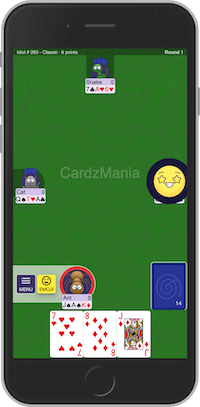Overview
Palace is a classic card game where players try to not be the last person to get rid of their cards. Palace is played with 2 to 12 people.
Ranking of Cards
Aces are high and 3s are low.
In Palace, 2s also known as the reset card, are wild, 5s change the direction of play when enabled, and 10s remove the current pile while allowing the person who played it to start the next pile.
Another interesting twist in Palace is that if you end up playing all cards of the same value (four of a kind) on the pile, they work just like playing a 10 and remove the current pile after which the person who played the last card gets to start the next pile. These consecutive four cards can be played in one turn or over multiple turns.
Play Multiplayer Palace Online
The Deck and the Deal
The dealer passes out nine cards to each player. The first three are placed face down in three piles in front of the player. The next three are placed face up on top of the last three cards. The final three make up the player's hand. The remainder of the deck is placed face down in the gameplay area to form the stock.
Before the game begins, players have the opportunity to exchange any cards in their hand with any of their face up cards.
How to Play
Beginning with the player left of the dealer and going clockwise, players try to outrank or match the previous card played. If they cannot do so, they must take the entire pile of played cards and begin a new pile. They can also try their luck by playing the top card from the stock (if remaining) - play continues if it's a valid move, otherwise they draw the entire pile including the newly drawn card. Players can also play multiple cards of the same value. Players must always have at least three cards in their hand. At the end of their turn, they replenish their hand by drawing cards from the stock.
Once the stock runs out and the player runs out of cards from their hand, their three face up cards become their new hand. If they can't play a valid card, they play any card from their face up cards on to the pile which they now pick up to form their hand. They cannot use the remaining face up cards until they can once again empty their new hand. Once all their face up cards are used , the player uses the face down cards one at a time; they must get rid of the card that they chose first in order to move on to the next face down card. They just play the face card down and hope for the best. If it's a legal play, the game goes on as normal, and if it's not, the player picks up the pile along with the card they just played to form their new hand. The player has to get rid of all these cards to play their next face down card.
Play continues until everybody has played all of their cards from their hand, face up cards and face down cards.
Scoring
Players score penalty points depending on the order in which they got rid of all of their cards. The first player to do so scores no penalty points, the second player scores 1 penalty point, the last player scores 3 penalty points and all other players score 2 penalty points.
Winning
The player who gets rid of all of their cards first wins the round. The game ends when one player has accrued 6 penalty points. The winner is whoever has the fewest points.
Variations
CardzMania supports several customizable rules and options so you can play Palace exactly how you like or how you grew up playing with your friends and family. In addition to the classic way of playing, we often have new creative options for you to try to spice up the game if you are interested in trying different spins for fun.
Points
Players determine a set amount of points when the game ends.
Rounds
Players determine a set amount of rounds (also known as hands or deals) that the game will go to (instead of the points selection above).
Timer
Players only have a set amount of time to make their turn after which a turn is automatically played for them and the game proceeds: Fast is 7 seconds, Standard is 15 seconds, Slow is 30 seconds, and Very Slow is 60 seconds. Players can also choose to disable the timer, but that is only for private tables.
Cards per player
Players can determine the amount of cards they play with. By default, everyone gets 3 cards each for their hand, face up and face down cards i.e. a total of 9 cards. The other option available is 4 cards each for hand, face up and face downs cards i.e. a total of 12 cards.
Decks
Players can determine the amount of decks they play with. You can choose one deck (52 cards), two decks (104 cards) or three decks (156 cards). Decks will automatically be added when needed otherwise. For example, you can't play a 12 players game with just one deck as each player needs 9 cards, since we need at-least 9 cards x 12 players = 108 cards, in this case, irrespective of the decks selection, three decks will automatically be used.
Discard pile
Players can determine when to discard the pile when more than one deck is used. With a single deck, the pile is discarded when all four same valued cards are played. With more than one deck, you can choose whether to discard the pile with at least four same valued cards or all possible valued cards i.e. eight cards for two decks and twelve cards for three decks.
Low card
Players can determine which card functions like the default 5. Options for this card are 5s (default), 6s or 7s.
Low card sticks
Players can determine if the low card sticks for all subsequent turns (not just one turn) until someone plays a low card again to switch it back to high.
Direction card
Players can determine if they'd like to play with 9s to switch direction of play i.e. instead of going clockwise, after someone plays a 9, you start going anti-clockwise. Currently 9s are the only option available as a direction card.
Skip card
Players can determine if they'd like to play with a card that skips the next player's turn. The options available are 8s, Queens, Kings or Aces. The next player skips their turn when this card is played. In case of only two players, the same player who played the card takes another turn.
Special cards anytime
Special cards (low card, direction card, skip card) can be played anytime - 2s and 10s are wild and are always special. For example if you have 5s as the low card, by default you can't play this card anytime (on top of a 6 on the pile for instance). When disabled, this restriction goes away and you can play all special cards anytime during the game irrespective of what's on the pile just like 2s and 10s.
Jokers
Players can choose to play with jokers. Sometimes they are added instead of adding an entire deck to accomodate for more players, for example for a six player game, adding two jokers means with a 54 card deck, you can play with 9 players. Jokers can be played anytime just like 2s and 10s and are transparent, meaning that they don't have any effect on the value and the next player has to match or beat the card below the joker.
Classic Basics
Classic games vary to a great degree in terms of rules and objectives. A thread that binds them all is their simplicity and age. Classic games are typically easy enough for young children to play them and have typically been around for many years.
Card Game Basics
A deck of cards consists of 52 cards, with 4 distinctive subgroups. Each of these subgroups is recognised by a symbol and are referred to as suits. They consist of Clubs, Spades, Hearts and Diamonds. Each suit contains 13 cards which, generally, are considered in this order, Ace (A), 2, 3, 4, 5, 6, 7, 8, 9, 10, Jacks (J), Queen (Q) and King (K). Some games include the two Jokers found in a standard deck but most games don't.
Feedback
Would like to discuss new features or variations for Palace? Need a custom rule? Have a question? Got a suggestion? Don't see a game you want to play? Please contact us by
email, facebook or twitter - we really value your feedback and love hearing from all of you!
This site uses cookies. By continuing to browse the site you are agreeing to our use of cookies.




